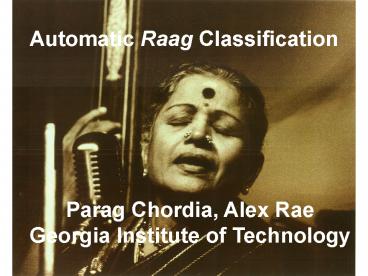Automatic Raag Classification - PowerPoint PPT Presentation
1 / 14
Title: Automatic Raag Classification
1
Automatic Raag Classification
Parag Chordia, Alex RaeGeorgia Institute of
Technology
2
What is raag?
vadi
samvadi
Ascending C D G E F A G C Descending C B A G F
E D C
Scale
D G E F A G E F D C
Surface
G F E F
E F D C
E F A G
D G
G E
G F E F
Motives
3
Motivation
- Natural way of searching for ICM
- Highly correlated with mood descriptors
- Indian music auto DJ
- Starting point for most automated analyses
4
Problem
- Hard typically takes 5-10 years of active
listening to discern large set of raags - 100 common raags
- Shared gestures between raags
- Same notes used in different raags
5
Basic Idea
- Want a technique that does not rely on finding
specific note sequences - Note that use of phrases leads to a tonal
hierarchy - Pitch-class distribution has been effectively
used to model tonal hierarchies in Western tonal
music
6
PCD Feature Extraction
Divide into 30s frames
Pitch-track using HPS
Onset-detection (complex DF)
Histogram pitch values
7
PCD Example
8
PCDD Feature Extraction
Segment into notes
Assign single pitch-class to each note
CDGDGEFAGFGAGC
Construct bi-grams
Count bi-grams
9
Classification
PCD, PCDD feature vectors
10-Fold CV
Unseen
Split Criteria
Test data
Training data
SVM
MVN
FFNN
Random Forests
Trained model
Estimate error
10
Raag Database
- 31 different raags total of 20 hours
- 6 instruments
- sitar, sarod, bansuri, shenai
- vocal (male and female)
- Wide variety of musical forms
- different sections, densities, rhythms
11
(No Transcript)
12
Results
13
Discussion
- Nearly perfect in CV experiment
- PCDD increases performance by 20
- PCDD not generalizing well across recordings
- Why?
- sensitivity to onset detection errors
- However substantial melodic variation even in
segments from same recording
14
Future Work
- Automatically identify tonic (sa)
- Robust to accompaniment
- Improve tonal onset detection
- Do we need more general n-gram model?































